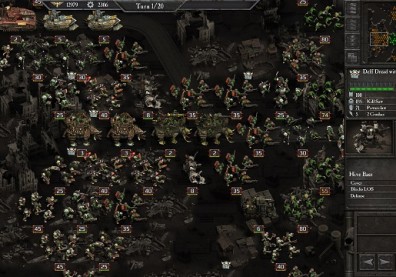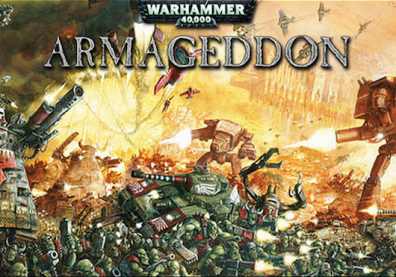Warhammer 40,000: Armageddon is one of several new games set in the robust Warhammer universe to have been released this past year. The Warhammer 40,000 game, the most popular and best selling of the Games Workshop miniature series, has been on shelves since its inception in 1987. In the past nearly three decades there have been over a dozen titles in the sci-fi setting alone, with countless others in the Warhammer Fantasy, line among others.
The Banner Saga 2 Announced At The Game Awards; Coming To Consoles In 2015
Yet in all that time, I have such limited experience with Warhammer that I may as well have none. I have never actively resisted the series, I simply have never sought it out with any great enthusiasm, either. I am a near complete outsider to the universe. Slitherine, the company behind Armageddon, certainly did not create a game specifically for a newcomer like me, but the game’s reliance on standard sci-fi and fantasy tropes and familiar strategy makes it easier for both veteran and greenbacks alike to enjoy, up to a point.
Told over three acts and 30 missions, Warhammer 40,000: Armageddon puts you on the front lines of an Ork invasion onto the hotly contested Imperial world of Armageddon and all the battling, bickering and political gamesmanship that that entails. For me, the newcomer, it seems like a wonderfully deep world that is torn down by a lack of visuals.
Nooo! The Witcher III: Wild Hunt Delayed Again Until May
I am not a graphics guy by any stretch of the imagination. The arms race between Sony and Microsoft to Uncanny Valley themselves into non-existence does not concern me nearly as much as the gameplay possibilities of the current generation, but even I think the graphics in Armageddon are antiquated. The units are little more than inanimate tilepieces to place on a board. The lack of any real FMV outside of the opening cinematic and the staid, barely animated unit actions seem like they belong in a Red Alert title from 1998, not 2014.
Nor does it have to be that way. Looking at recent titles like Civilization: Beyond Earth, you realize that good mechanics and an engaging sense of style do not have to be mutually exclusive. When creating a boardgame title, you can give it a few flourishes the new medium allows.
The gameplay is the saving grace of Armageddon. Much like how chess is always chess no matter the resolution, the core mechanics of the title are solid and fairly easy to understand. At the beginning of a map, players deploy a certain number of units they have pre-selected for a mission. Each unit is afforded one move and one action or attack during the turn, though a player can select which to do first. Every unit has a set of traits, Armor, Piercing, Movement, etc that varies between the several different class of units you have. Infantry is weak, but can move across almost anything, artillery is powerful but poorly defended and the Titan can just murder anything it comes across, but needs a lot of protection.
Most of the time, though, you’ll be approaching encounters in a ‘Well, this might work’ type of mind. Longtime Warhammer players will understand the minutiae and rock-paper-scissors strengths and weaknesses skills of every unit, but my time was largely spent throwing hell and creation at everything. The game almost stubbornly refuses to explain just what each number means, though you can eventually work out some of the more basic ones. How each unit stacks up against your opponent’s is a matter of trial and error.
That level of obtuseness is prevalent throughout the game. You don’t always notice it, but a situation will inevitably arise that frustrates you. I nearly lost one scenario early on because the Mission Objectives pane did not update itself with the new orders, nor did it highlight the three points I was supposed to fall back to in order to secure victory. In fact, it never highlights the multitude of Victory Hexes in the game. Most are obvious, but some are at times hard to understand. My impression of the Warhammer tabletop strategy game is one of exclusion: it’s a super-secret society and my invite was lost in the mail. Armageddon, on the other hand, simply invites me over and plops me down in a remote corner while the adults go about their business. It’s fascinating to watch, fun at times, but I can’t help but feel I am missing out on something.
The number of units available to players can choose from in Armageddon stands at approximately 350. I am the kind of player who gets stuck in a early-game mindset: I like having the freedom to choose among certain units, but 350 is just far too many. When they become unlocked over the course of the campaign, I find myself still relying on my old standbys, even if those tanks really, really don’t belong in this swamp section at all. Nor are the units noticeably different. An armor piercing differential of 10% is all that separates several lines of tanks and artillery. Hardcore strategy players will revel at the minor upgrades, but newcomers will be intimidated by the numbers. Another example of someone else getting the joke while you scratch your head in bewilderment. Do we need so many variations on this single theme?
There is a lack of ceremony in Warhammer 40,000: Armageddon. A particularly engaging mission will simply end with a victory or defeat screen, offering little resolution. Units trade bullets or melee barbs and, when killed, simply disappear in a puff of smoke. The “cutscenes” are protracted text-based mission briefings in which you verbally spar with your superiors, bring the 30 campaign missions from point A to point B with as little fanfare as possible. Much like chess, the game is ultimately not out to entertain you, but to make you work, plan and strategize. But there is nothing in the rulebook on game creation that says you can’t have both.
-------------
Warhammer 40,000: Armageddon was reviewed on a PC using a code provided by the publisher. The game is available now via Steam for $39.99.









